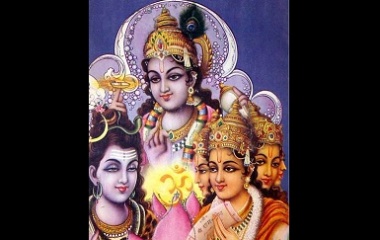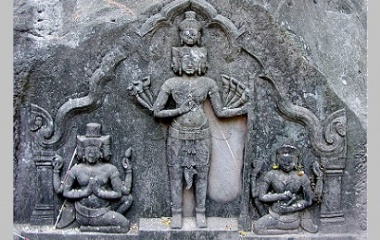- Pronunciation: trih-moo-r-tee
- Origin: India
- Role: Trinity of supreme divinity
- Wives: Saraswati, Lakshmi and Parvati
What Is Trimurti?
In the Hindu religion, the concept of the cosmos is personified by a triad of deities, namely the Trimurti. The Trimurti or triad is also referred to as Brahma-Vishnu-Maheshwara, which stands for Brahma the creator, Vishnu the preserver, and Shiva the destroyer.
The three represent the aspects of human existence: birth, life and death. Although there are many depictions of the Trumurti, often they have three heads branching from one neck, each gazing in a different direction.
The Trimurti was introduced in the Rig Veda, the oldest of the sacred Hindu books, and written in the ancient form of Sanskrit in approximately 1500 B.C. Although each of the deities has their own role and their attributes are differentiated, many Hindus believe they are manifestations of a single god with variant properties.
Origin
Brahma
Brahma is the first of the gods of the Trimurti: the creator. There are multiple theories of how he came into being. Some myths have him born from the female primordial energy called Maya and the supreme being Brahman, from his seed in the water transforming into an egg. Others say he was born from a lotus flower. Either way, he was the first of the Trimurti, and he created the universe with the help of the 11 forefathers of the human race, Prajapatis, the seven sages Saptarishi, and the “mind children” born from his brain not his body, the Manasputras. He also created Vishnu and Shiva and is considered the originator of all of the Hindu gods.
Brahma has four faces, which represent the four Vedas and the four corners of the universe. The Rig-Veda, Yajur-Veda, Sama-Veda, and the Atharva-Veda are the ancient Hindu texts. Originally he had five heads, but according to the legends, Shiva cut one of them off in a fit of rage. He also has four arms, red skin and he never carries a weapon – just a jar of holy water, a spoon and the book of Vedas. He wears a mala, (Hindu prayer beads). Similar to the other deities in Hindu mythology, he sits upon a lotus flower.
There are very few temples in India dedicated to Brahma. The largest is in Pushkar, one of the oldest cities, located in the state of Rajasthan. There are temples dedicated to him in other countries.
Vishnu
The second god of the Trimurti is Vishnu, the Lord of Preservation and Sustenance. He is the supreme god of the Vaishnavites, a tradition of Hinduism. He preserves the universe and is highly valued throughout all the belief systems. He is often considered more powerful and of greater importance than Brahma. He sometimes appears in a reclining position with Brahma emerging from his navel, so there are myths that say he even created the creator.
Vishnu can take different forms which represent his various manifestations and functions. He is depicted as blue in color, and holds a lotus flower, mace, a shell and the chakra wheel which represents the seven energy forces present in the human body.
He is widely worshipped in his original form or in the form of one of his avataras (manifestations in an alternate form). There are many temples dedicated to Vishnu all over India. One of largest and most famous is the Sri Ranganathaswamy Temple which spans 156 acres and contains 49 shrines all dedicated the Lord Vishnu.
Shiva
The third deity of the Trimurti is Shiva, the destroyer and transformer. He is the slayer of demons and has authority over death, rebirth and immortality, all revered concepts in Hindu mythology.
The worshippers of Shiva are called Shaivites, and they believe that he is the ultimate deity. His habitat is Mount Kailas, a real mountain in Tibet. He stays there in a perpetual state of meditation and accompanied by his wife. He represents the primal soul and the truth of reality and consciousness to his believers.
He was previously known as Rudra, but now Shiva is more commonly used, and they have the exact same personalities and traits so the two are considered interchangeable. Images of Shiva show him as a handsome and strong youthful man usually meditating or dancing. He has a third eye, which he opens when he feels particularly disturbed. A crescent moon on his head signifies that he controls his own mind. In statues he is also depicted with snakes wrapped around his neck and arms signifying his powers over evil. He wears earrings in both ears as a sign of fertility, sexual power and union. He is considered the patron deity of yoga and meditation.
Shiva worship frequently makes use of the linga, a vertical rounded column similar to the lingas of ancient Egypt that were phallic symbols that also represented gods. Some say they just represent his regenerative energy.
Temples of Shiva are commonplace all over India. In the south there are five well known temples that represent each of the five elements: fire, water, air, earth and space.
Wives of Trimurti
Each of the three supreme deities of the Trimurti had a wife who is considered a very important counterpart in the mythology. Brahma’s wife is Saraswati, the goddess of knowledge and the arts. Her name is a combination of two words, saras, which means flow and wati, which means woman.
It is her job to subdue Brahma’s wandering mind. When the universe was first created, Brahma had five heads. He watched the first of the goddesses – Sharupta – obsessively, which was a distraction from finishing the rest of creation. As a result, Shiva came along and cut off one of his heads. After that unfortunate occurrence, he married Saraswati and she helps him to focus and hold on to his remaining four faces.
The wife of Vishnu is Lakshmi, the goddess of love, beauty and prosperity. She is a cultural favorite, especially with women, and has multiple arms in which she holds gold coins.
Shivas’ wife Pavarati is the goddess of power and transformation. She is the reincarnation of his first wife Sati, who jumped into a fire because her father disapproved of her marriage. When she was reborn as Pavarati many hundreds of years later, she suffered the penances of Sati, including periods of starvation, until Shiva accepted and married her. Her story and their union is representative of the fact aspirations can overcome human suffering and lead to the achievement of nirvana, happiness and freedom from reincarnation.
Modern Influence
Modern Hinduism has various factions and there is not a single unique philosophy. Most of the belief systems stem back to the Trimurti. Smartism is a contemporary version in which it is believed the three deities are manifestations of a supreme higher power that has no form. The Shaktis believe that all three deities came from the divine mother, and they are aspects of her nature. Some cults worship Vishnu, others Shiva, and some see divinity in all of nature. They are all considered good Hindus.
All over the world, the sound of Om is the symbol of Hinduism. It’s the primordial sound, the very breath of creation, and the justification for our very existence. According to the legend, it all began with the Trimurti.










